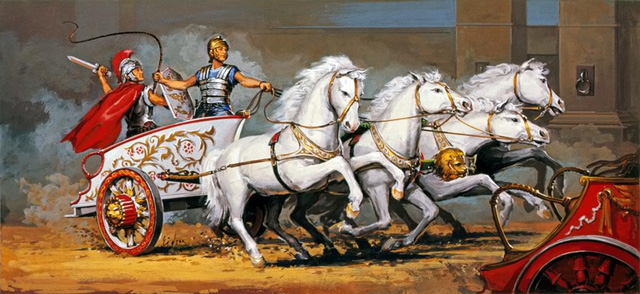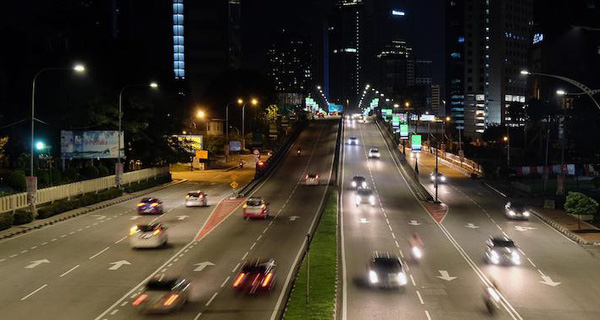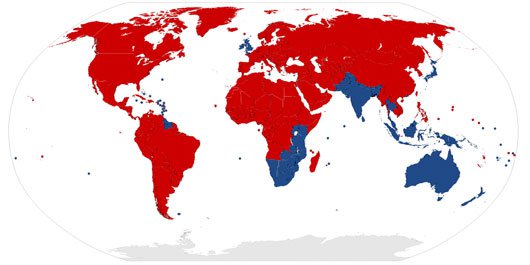Why are you and many other countries in the world driving on the left?
You are surprised to know that up to 76 countries and territories around the world still apply the ride rules on the left side road. Why? What's the difference between driving on the right and on the left and which side driver is there first? Let's go back to history to find the answer.
According to historians, the left-hand comes from the Greek, Egyptian, and Roman times. Most people are right-handed, one riding a horse with his left hand or driving a cart with his left hand, and his right hand is free to greet the person who goes against or is willing to draw the sword to fight or defend when needed.

The Romans controlled horses with their left hand.
From that habit, walking to the left becomes a tradition and then is set into law. The law on the left is very well applied in Roman times.
By 1300 BC, Pope Boniface VIII asked for instructions on how to force all pilgrims to Rome to go to the left of the road.
The way to move is also gradually shifting to the right because people no longer carry a dance when traveling on the road. By the end of the 18th century, carriage drivers in the US and France began using pairs of horses to transport agricultural products. These cars do not have a seating position for humans, so the drivers must sit on the back of the last horse on the left to whip their right hand. Because of sitting on the left, you will want someone to walk in the opposite direction to your left to easily observe the collision. Therefore, you must go to the right of the road.
In 1792, the law mandated traffic participants towards the right side of the road to be issued in the US state of Pennsylvania. In the following years, other states also adopted this law.
After the French Revolution of 1789, Napoleon asked soldiers under the right to go right and into rows, then this rule also applies to vehicles. The Netherlands, Germany, Switzerland, Poland, Italy, and Spain, allies allied with France have also established ways to go right. In Austria the ways in each city have different modes of transportation, but then the country agreed to go right.

Both South Korea and Korea after escaping from Japanese occupation in 1946 also moved to the right. Later, Czechoslovakia and Sweden also chose to go to the right. In the US, people first chose to go to the left but then moved to the right.
In the UK, since 1773, the government has set a standard for driving on the left side of the road.
Both England and France apply their own driving style to colonial countries. So far, some of the former British colonies still keep the tradition of left-hand ride like India, Indonesia, .
African countries choose to move to the right or left because of the influence of neighboring countries. Some of the former British colonies had moved to the right, followed by the neighboring countries which were French colonies. Some other Portuguese colonial countries changed their neighbors' movements, which were British colonies.

In the driving countries on the left, the cars also design the steering wheel accordingly, ie on the left. But in some parts of the world, such as the US Virgin Islands, the British Virgin Islands, the Cayman Islands, Turks & Caicos Islands and the Bahamas, although driving on the left, there is a steering wheel on the left due to most vehicles. All transfers are imported from the US and Brazil.
The places where the driving law applies

Driving countries on the left (blue)
Although contrary to the trend of the world, the driver on the left is still traditional and regulated in the country of fog. In addition to the UK, many other countries still apply this rule.
British territories and British autonomous regions : British Virgin Islands, St. John's Island Helena, Anguilla Island, Cayman Islands, Isle of Man Island, Falkland Islands, Montserrat Island, Turks & Caicos Islands.
Asia : Bhutan, Bangladesh, Brunei, India, Hong Kong, Indonesia, Macau, Japan, Malaysia, Pakistan, Singapore, Nepal, Sri Lanka, Thailand.
Europe : Ireland and Northern Ireland, Cyprus, Malta, Wales, Scotland.
Africa : Kenya, Botswana, Lesotho, Mauritius, Malawi, Mozambique, Seychelles, Namibia, South Africa, Surinam, Tanzania, Swaziland, Tonga, Rwanda, Zambia, Trinidad & Tobago, Zimbabwe.
America : Bahamas, Antigua & Barbuda, Barbados, Dominica, Bermuda, Grenada, Jamaica, Guyana, St Kitts & Nevis, US Virgin Islands, St. Lucia, St. Vincent & Grenadines.
Oceania : Fiji, New Zealand, Australia, Samoa, Papua New Guinea, Solomon Islands.
You should read it
- Can self-driving cars solve traffic jams?
- Top app makes you safer when driving
- Take a ride on Tesla's self-driving car and watch the self-driving Tesla car video on the real road
- TOP app supports the best driving test on phones
- How to Turn Off Driving Mode
- How to handle frosted glass, blurry mirror for drivers when it is raining
- Summary of the latest Driving Empire code and how to enter
- Instructions for registering to change international driving licenses online
May be interested
- Admire the beauty of 10 tiny countries in the world
 there are over 200 countries and territories in the world, do you know all about them? let us admire the beauty of the 10 tiny countries in the world in the article below!
there are over 200 countries and territories in the world, do you know all about them? let us admire the beauty of the 10 tiny countries in the world in the article below! - Why are some people left-handed while most of us are right-handed?
 did you know, 1/10 of the world population is left-handed and this has existed 500,000 years ago. and it is a fact that we cannot choose the right hand, because this is decided since the human being is not born, still in the womb.
did you know, 1/10 of the world population is left-handed and this has existed 500,000 years ago. and it is a fact that we cannot choose the right hand, because this is decided since the human being is not born, still in the womb. - Elon Musk: Tesla's self-driving car will amaze the world
 tesla's self-driving cars are cheap, beautiful, and environmentally friendly and stylish, what do you want more in a car?
tesla's self-driving cars are cheap, beautiful, and environmentally friendly and stylish, what do you want more in a car? - TOP app supports the best driving test on phones
 these are driving learning applications on the phone, allowing users to review theory, test driving theory tests.
these are driving learning applications on the phone, allowing users to review theory, test driving theory tests. - While many countries are 'flooded with garbage', the country is importing waste to use
 while most countries in the world, including the most developed countries in the world, are suffering from waste because there is no place to bury and pollute the environment, this country has to import garbage from other countries. use.
while most countries in the world, including the most developed countries in the world, are suffering from waste because there is no place to bury and pollute the environment, this country has to import garbage from other countries. use. - How to Turn Off Driving Mode
 this wikihow teaches you how to disable driving mode on your iphone or android. driving mode is a setting which turns off your phone's notifications when it detects that you're in a moving vehicle. disable driving mode temporarily. on an...
this wikihow teaches you how to disable driving mode on your iphone or android. driving mode is a setting which turns off your phone's notifications when it detects that you're in a moving vehicle. disable driving mode temporarily. on an... - Tips for safe driving at night that you may not know
 driving at night is actually more dangerous than during the day. according to the traffic police department, fatal accidents are three times more likely to occur at night than during the day.
driving at night is actually more dangerous than during the day. according to the traffic police department, fatal accidents are three times more likely to occur at night than during the day. - How to handle frosted glass, blurry mirror for drivers when it is raining
 the driving glass is blurry, the rearview mirror is blurry or skidding, driving loss is a situation of driving cars often in rainy weather. here are good tips to help the driver handle quickly in the above situations.
the driving glass is blurry, the rearview mirror is blurry or skidding, driving loss is a situation of driving cars often in rainy weather. here are good tips to help the driver handle quickly in the above situations. - [Infographic] Countries with the fastest Internet speed in the world
![[Infographic] Countries with the fastest Internet speed in the world](https://tipsmake.com/img/no-image-80-80.png) today, the internet has become an integral part of modern life. so do you know, which country has the fastest internet speed in the world?
today, the internet has become an integral part of modern life. so do you know, which country has the fastest internet speed in the world? - How to Turn Off Driving Mode
 today's tipsmake will guide you how to turn off driving mode (or driving mode) on iphone and android phones. driving mode is a setting that turns off notifications on your phone when it detects you're in traffic.
today's tipsmake will guide you how to turn off driving mode (or driving mode) on iphone and android phones. driving mode is a setting that turns off notifications on your phone when it detects you're in traffic.








![[Infographic] Countries with the fastest Internet speed in the world](https://tipsmake.com/data/thumbs_80x80/[infographic]-countries-with-the-fastest-internet-speed-in-the-world_thumbs_80x80_TS397x8rY.jpg)

 Unexpected code decoding on New Year's Day
Unexpected code decoding on New Year's Day Why do beautiful girls often choose to love bad boys?
Why do beautiful girls often choose to love bad boys? Science proves better to be single than to love the wrong person
Science proves better to be single than to love the wrong person Developing thinking and teaching children to learn math with Lego toys
Developing thinking and teaching children to learn math with Lego toys Why does lightning do not affect aircraft while flying?
Why does lightning do not affect aircraft while flying? 5 interesting things about the Japanese education system make the whole world jealous
5 interesting things about the Japanese education system make the whole world jealous